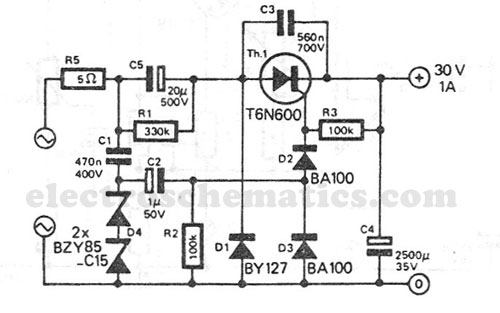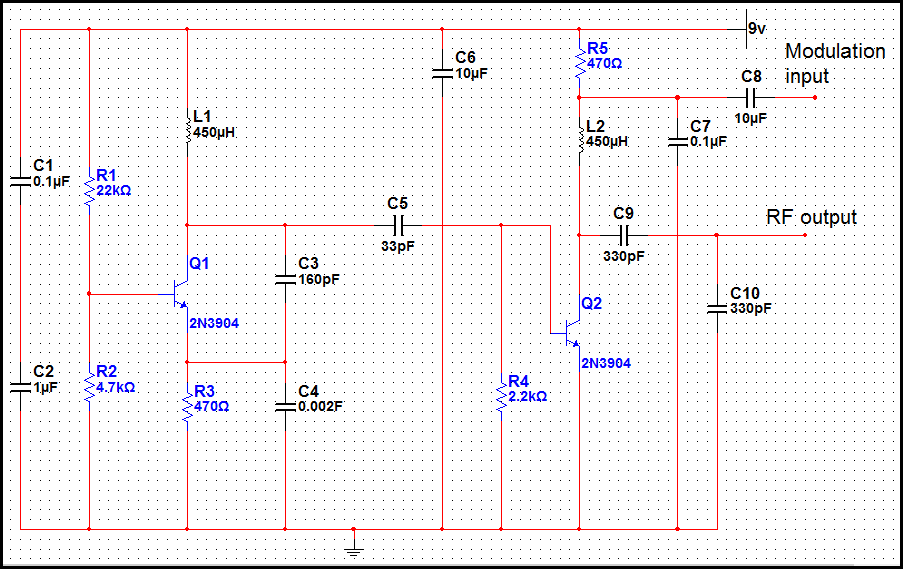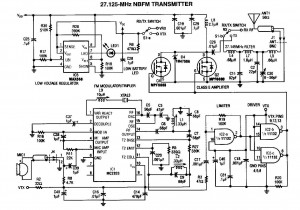
BA1404 5W FM Transmitter Power by Fmuser Guanghzou China office

The circuit consists of a few components, specifically four, to create a miniature wireless FM microphone. It operates with a stable frequency, achieving a range of over 10 meters with a 1.5V supply and a current consumption of less than 0.5mA, making it energy-efficient. When powered by a 3V supply, the range extends up to 30 meters. The circuit includes a high-frequency oscillator formed by the transistor junction capacitance, which is approximately 2 to 3 picofarads, allowing the FM frequency to be within the range of a coil with a diameter of 5mm around a core with 7 turns. The condenser microphone modulates the frequency based on vibration, resulting in frequency offset for FM transmission. The emission current, distance, and size are controlled by resistance values that should be between 300 and 500 ohms, ensuring power consumption remains below 1mW. The selected transistor (BG) must have a cutoff frequency (fT) greater than 300MHz, such as the 2SC3358, to maintain frequency stability and enhance transmission distance. The inductance (L) is divided into two coils, both wound uniformly; L1 uses 0.5mm enameled wire with 4 turns, while L2 has 3 turns. The antenna can be a 10cm length of soft wire, and touching the antenna will affect frequency changes, although the circuit remains stable when used in a fixed location. The compact design allows the circuit to fit into a small ink bottle, and it can be installed in a pen, powered by small batteries like the A13, but it is important to include a switch for operation.
The miniature wireless FM microphone circuit is designed with simplicity and efficiency in mind, utilizing only four main components to achieve its functionality. The core of the circuit is a high-frequency oscillator, which is crucial for generating the FM signal. The transistor junction capacitance plays a pivotal role in determining the oscillator's frequency, with a capacitance value in the range of 2 to 3 picofarads. This small capacitance allows for a compact design while maintaining effective operation within the desired frequency range.
The coil design is critical for the circuit's performance. A coil with a diameter of 5mm and 7 turns is recommended to optimize the inductance required for stable operation. The use of a condenser microphone enables the modulation of sound signals into frequency variations, which is essential for FM transmission. The circuit's design must ensure that the resistance values are carefully chosen to maintain the balance between current draw and transmission range, with a specified range of 300 to 500 ohms to optimize performance while keeping power consumption below 1mW.
The choice of transistor is also significant, as it must have a cutoff frequency greater than 300MHz to ensure reliable operation at the desired frequencies. The 2SC3358 transistor is a suitable choice for this application due to its high-frequency capabilities, which contribute to improved signal stability and extended transmission distances.
The inductance is split into two coils, L1 and L2, which must be wound uniformly to ensure consistent performance. L1 consists of 4 turns of 0.5mm enameled wire, while L2 has 3 turns. This configuration helps in achieving the desired inductance while maintaining a compact form factor.
For the antenna, a length of 10cm soft wire is sufficient for effective transmission. It is important to note that the antenna's performance can be influenced by physical interaction, such as touching, which may lead to frequency changes. However, the circuit exhibits stable performance when positioned in a fixed location.
Overall, this miniature FM microphone circuit is designed for versatility and can be housed within a small ink bottle or integrated into a pen. The use of compact batteries, like the A13, allows for portability, while the inclusion of a switch facilitates user-friendly operation. The design is well-suited for applications requiring a compact, efficient, and reliable wireless audio transmission solution.Circuit with a few components, only four to form a miniature wireless FM microphone, a more stable operating frequency, firing range of more than 10 meters, 1. 5V supply, the current less than 0. 5mA, so that the microphone energy also rare, 3V supply when the distance of up to 30 meters. Circuit shown in Figure, BG and L and the transistor junction capacitance high-frequency oscillator circuit composed of transistor junction capacitance of about 2 ~ 3P, make the FM frequency falls within the scope of the coil should be 5mm in diameter around the core 7 of a circle, then by the condenser microphone modulated with a frequency of vibration when the signal generator frequency offset, to achieve FM. The emission current distance and the size of the emission control work, the resistance can not come too big nor too small, between 300 and 500 in Europe, less than 1 mW power.
BG when selected, the pipe must be greater than fT 300MHz, such as high frequency with 2SC3358 tube, the frequency is more stable, longer distance will be more. Inductance L divided into two coils around the system, but to be the same around, L1 0. 5mm enameled wire with a diameter of 5mm in diameter and 4 turns around the skeleton, L2 3 turns around.
Antenna can be 10cm long soft wire, use hand to touch the antenna will affect the frequency of changes. When used at a fixed location is very stable. This circuit can be put into such a small ink bottle, the kit can be installed in the pen, battery or more small batteries A13, but note that a small-capacity battery plus a switch.
🔗 External reference
The miniature wireless FM microphone circuit is designed with simplicity and efficiency in mind, utilizing only four main components to achieve its functionality. The core of the circuit is a high-frequency oscillator, which is crucial for generating the FM signal. The transistor junction capacitance plays a pivotal role in determining the oscillator's frequency, with a capacitance value in the range of 2 to 3 picofarads. This small capacitance allows for a compact design while maintaining effective operation within the desired frequency range.
The coil design is critical for the circuit's performance. A coil with a diameter of 5mm and 7 turns is recommended to optimize the inductance required for stable operation. The use of a condenser microphone enables the modulation of sound signals into frequency variations, which is essential for FM transmission. The circuit's design must ensure that the resistance values are carefully chosen to maintain the balance between current draw and transmission range, with a specified range of 300 to 500 ohms to optimize performance while keeping power consumption below 1mW.
The choice of transistor is also significant, as it must have a cutoff frequency greater than 300MHz to ensure reliable operation at the desired frequencies. The 2SC3358 transistor is a suitable choice for this application due to its high-frequency capabilities, which contribute to improved signal stability and extended transmission distances.
The inductance is split into two coils, L1 and L2, which must be wound uniformly to ensure consistent performance. L1 consists of 4 turns of 0.5mm enameled wire, while L2 has 3 turns. This configuration helps in achieving the desired inductance while maintaining a compact form factor.
For the antenna, a length of 10cm soft wire is sufficient for effective transmission. It is important to note that the antenna's performance can be influenced by physical interaction, such as touching, which may lead to frequency changes. However, the circuit exhibits stable performance when positioned in a fixed location.
Overall, this miniature FM microphone circuit is designed for versatility and can be housed within a small ink bottle or integrated into a pen. The use of compact batteries, like the A13, allows for portability, while the inclusion of a switch facilitates user-friendly operation. The design is well-suited for applications requiring a compact, efficient, and reliable wireless audio transmission solution.Circuit with a few components, only four to form a miniature wireless FM microphone, a more stable operating frequency, firing range of more than 10 meters, 1. 5V supply, the current less than 0. 5mA, so that the microphone energy also rare, 3V supply when the distance of up to 30 meters. Circuit shown in Figure, BG and L and the transistor junction capacitance high-frequency oscillator circuit composed of transistor junction capacitance of about 2 ~ 3P, make the FM frequency falls within the scope of the coil should be 5mm in diameter around the core 7 of a circle, then by the condenser microphone modulated with a frequency of vibration when the signal generator frequency offset, to achieve FM. The emission current distance and the size of the emission control work, the resistance can not come too big nor too small, between 300 and 500 in Europe, less than 1 mW power.
BG when selected, the pipe must be greater than fT 300MHz, such as high frequency with 2SC3358 tube, the frequency is more stable, longer distance will be more. Inductance L divided into two coils around the system, but to be the same around, L1 0. 5mm enameled wire with a diameter of 5mm in diameter and 4 turns around the skeleton, L2 3 turns around.
Antenna can be 10cm long soft wire, use hand to touch the antenna will affect the frequency of changes. When used at a fixed location is very stable. This circuit can be put into such a small ink bottle, the kit can be installed in the pen, battery or more small batteries A13, but note that a small-capacity battery plus a switch.
🔗 External reference





